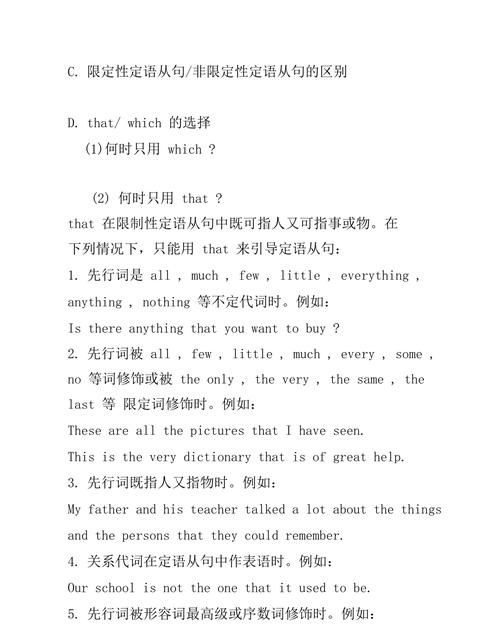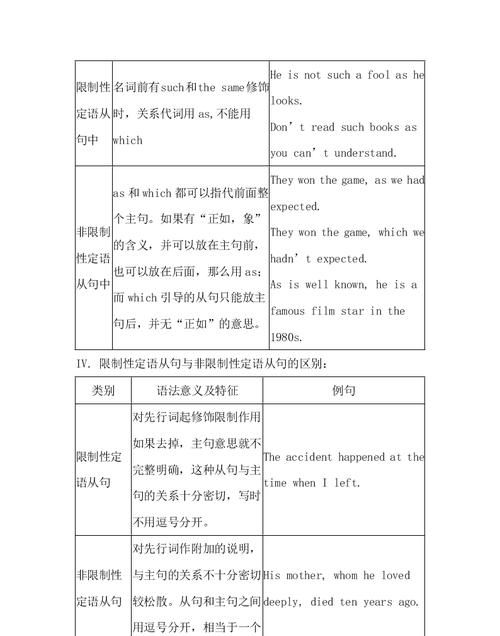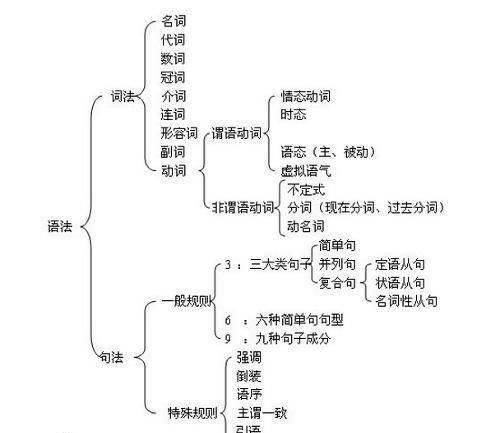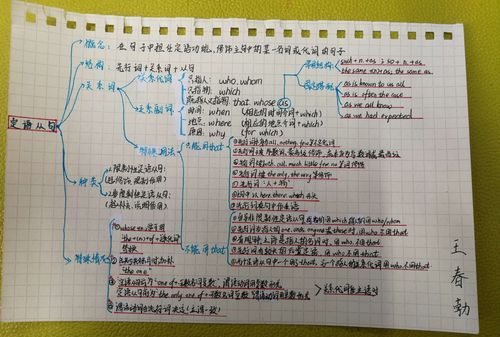本文目录
什么是定语从句举例说明
定语从句,是指一类由关系词引导的从句,因为这类从句的句法功能多是做定语,所以曾被称为定语从句,这类从句除了可以做定语之外,还可以充当状语等其他成分,所以现代语言学多使用“关系从句”这一术语。下面为大家带来了什么是定语从句举例,欢迎大家参考阅读!
什么是定语从句举例1
什么是定语从句
关系代词引导的定语从句
关系代词所代替的先行词是人或物的名词或代词,并在句中充当主语、宾语、定语等成分。关系代词在定语 从句中作主语时,从句谓语动词的人称和数要和先行词保持一致。
1)who,whom,that
这些词代替的先行词是人的名词或代词,在从句中所起作用如下:
Is he the man who/that wants to see you?
他就是想见你的人吗?(who/that在从句中作主语) He is the man whom/ that I saw yesterday.
他就是我昨天见的那个人。(whom/that在从句中作宾语)
2) Whose 用来指人或物,(只用作定语, 若指物,它还可以同of which互换), 例如:
They rushed over to help the man whose car had broken down. 那人车坏了,大家都跑过去帮忙。
Please pass me the book whose (of which) cover is green. 请递给我那本绿皮的书。
3)which, that
它们所代替的先行词是事物的名词或代词,在从句中可作主语、宾语等,例如:
A prosperitywhich / thathad never been seen before appears in the countryside. 农村出现了前所未 有的繁荣。(which / that在句中作主语)
The packagewhich / thatyou are carrying is about to come unwrapped. 你拿的包快散了。(which / that 在句中作宾语)
关系副词引导的定语从句
关系副词可代替的先行词是时间、地点或理由的名词,在从句中作状语。
1)when, where, why
关系副词when, where, why的含义相当于"介词+ which"结构,因此常常和"介词+ which"结构交替使用,例 如:
There are occasions when (on which) one must yield. 任何人都有不得不屈服的时候。
Beijing is the place where (in which) I was born.北京是我的出生地。
Is this the reason why (for which) he refused our offer? 这就是他拒绝我们帮助他的理由吗?
2)that代替关系副词
that可以用于表示时间、地点、方式、理由的名词后取代when, where, why和"介词+ which"引导的定语从 句,在非正式文体中that常被省略(正式文体中不可省略),例如:
His father died the year (that / when / in which) he was born. 他父亲在他出生那年逝世了。
He is unlikely to find the place (that / where / in which) he lived forty years ago. 他不大可能找到他四十 年前居住过的地方。
判断关系代词与关系副词
方法一: 用关系代词,还是关系副词完全取决于从句中的谓语动词。及物动词后面无宾语,就必须要 求用关系代词。例如:
(错) This is the mountain village where I visited last year.
(错) I will never forget the days when I spent in the countryside.
(对) This is the mountain village (which) I visited last year.
(对) I'll never forget the days (which) I spent in the countryside.
习惯上总把表地点或时间的名词与关系副词 where, when联系在一起。此两题错在关系词的误用上。
方法二: 准确判断先行词在定语从句中的.成分(主、谓、宾、定、状),也能正确选择出关系代词/关系 副词.先行词在从句中作主、定、宾语时,应选择关系代词;先行词在从句中作状语时,应选 择关系副词。
例如:(对)Is this the museum which you visited a few days ago?
(对)Is this the museum where the exhibition was held?
定语从句举例
(1)Is he the man who/that wants to see you? 他是那个想见你的男人吗?(who/that在从句中作主语)
(2)He is the man (whom/that) I saw yesterday. 他就是我昨天见到的那个人。(whom/that在从句中作宾语)
(3)The man whom you spoke to just now is our English teacher. 刚刚和你说话的那个男人是我们的英语老师。(whom在从句中作宾语)
注:who在定语从句中指人,作主语和宾语,作宾语时可省略;做及物动词或介词的宾语,可省略。
2,which,that 用来指物(有六种情况只可用that而不用which)
(用作主语、宾语,作宾语时可以省略),例如:
(1)The prosperity which/that had never appeared before took on in the countryside.农村出现了前所未有的繁荣。(which/that在从句中作主语)
(2)The package (which/that) you are carrying is about to comeunwrapped.你拿那个包裹快要散开了。(which/that在从句中作宾语)
什么是定语从句举例2
一、形容词作后置定语的几种情况
1.当形容词修饰由 any-,every-,no-,some- 和 -body,-one,-thing 等构成的复合不定代词时,形容词需要后置.
2.当形容词修饰起名词作用的 anywhere ,somewhere 时,通常后置.
3.以 -able 或 -ible 结尾的形容词一般充当后置定语,表示暂时的特征或现象,而且中心名词前大多有形容词最高级或 all,only,every 等.
4.以字母 a- 开头的表语形容词,如 asleep,awake,afraid,afloat,alive 等作定语时,通常后置.
5.else 修饰疑问代词时,须后置.
6.当形容词前有 so,more,most 等词修饰时,常后置.
7.形容词短语通常后置,其功能相当于一个定语从句.
8.两个或两个以上的形容词用 and 或 or 连接作定语,表示强调意义时要后置.
9.形容词比较结构须后置定语.
10.有些形容词作前置定语时和后置定语时所表达的意义不同.
二、副词 here,there,in,out,above,below,home,abroad,before,yesterday 等作定语时,需要后置.
三、介词短语作定语时须后置.
四、动词不定式(短语)作定语时须后置.
五、单个分词(包括现在分词和过去分词)作定语时,如果强调的不是永久的特点,而仅是分词本身的动作时,通常后置;分词短语则须作后置定语.例如:
六、定语从句通常用作后置定语.

who定语从句的用法及例子
定语从句who的用法例子已经为大家准备好啦,大家可以参考以下是知识点,了解定语从句的用法!
一、定语从句who的用法例子
who引导定语从句应注意的五个方面。
一、 who引导的定语从句的先行词是表示人的名词或代词。如:
The student who is answering the question is John. 正在回答问题的那个学生是约翰。
Anybody who breaks the laws will be punished. 任何违反法律的人都将受到惩罚。
二、 who是主格,在定语从句中作主语,此时不能省略。如:
The person who was here yesterday is a musician. 昨天来这儿的那个人是位音乐家。
但在非正式英语中,who亦可作宾语,且可以省略。如:
The man(who)I saw just now is Mr Li. 我刚才见到的那个人是李先生。
三、 在定语从句中,who在人称、数上和其前面的先行词保持一致。如:
Do you know the boy who is standing over there? 你认识站在那边的那个男孩吗?
四、 若先行词中既有人又有物,关系代词用that而不用who。如:
He watched the children and boxes that filled the car. 他看见了塞满汽车的孩子和箱子。
五、 若先行词前面有形容词最高级、序数词修饰,关系代词用that而不用who。如:
Yao Ming is the best basketball player that I know. 姚明是我知道的最好的篮球运动员。
Tom is the first boy that left the room. 汤姆是第一个离开这个房间的男孩。
注意事项
1、例:Do you know the person who talked to me
此时,先行词在从句中作主语成分,只能用who,而不能用whom
2、例:He is one of the students to whom i have talked
当介词提前,介词后必须用且只能用whom
3、例:Gina ,who lives in China is my friend.
当定语从句为非限制性定语从句时,只能用who。
4、例:Do you know the person whomwho省略不写 i talked to
当先行词在从句中作宾语成分时,whom who 都可以,也可以省略不写。
二、定语从句语法教学大全
定语从句是由关系代词和关系副词引导的从句,其作用是作定语修饰主句的某个名词性成分,定语从句分为限定性和非限定性从句两种.
(一) 限定性定语从句
1. that即可代表事物也可代表人,which代表事物;它们在从句中作主语或宾语,that在从句中作宾语时常可省略关系词,which在从句中作宾语则不能省略.而且,如果which在从句中作“不及物动词+介词”的介词的宾语,注意介词不要丢掉,而且介词总是放在关系代词which的前边,但有的则放在它原来的位置
2. which作宾语时,根据先行词与定语从句之间的语义关系,先行词与which之间的介词不能丢
3. 代表物时多用which,但在带有下列词的句子中用that而不用which,这些词包括all, anything, much等,这时的that常被省略
4. who和whom引导的从句用来修饰人,分别作从句中的主语和宾语,whom作宾语时,要注意它可以作动词的宾语也可以作介词的宾语
5. where是关系副词,用来表示地点的定语从句
6. when引导定语从句表示时间
〔注〕值得一提的是,表示时间“time"一词的定语从句只用when引导,有时不用任何关系代词,当然也不用that引导
By the time you arrive in London, we will have stayed there for two weeks.
I still remember the first time I met her.
Each time he goes to business trip, he brings a lot of living necessities, such as towers, soap, toothbrush etc.
7. whose是关系代词,修饰名词作定语,相当于所修饰成分的前置所有格
8. 当从句的逻辑主语是some, any, no, somebody, anybody, nobody, something, anything, everything或nothing时,常用there is来引导
(二)非限定性定语从句:
非限定性定语从句的作用是对所修饰的成分作进一步说明,通常和主句间用逗号隔开,将从句拿掉后其他部分仍可成立
1. which引导的非限定性定语从句来说明前面整个句子的情况或主句的某一部分
2. 在引导限定性定语从句时,that有时相当于in which, at which, for which或at which
Attitudes towards daydreaming are changing in much the same way that(in which) attitudes towards night dreaming have changed. 人们对白日做梦的态度正在改变,这与人们对夜间做梦的看法的变化有非常相似之处.
I like the music for the very reason that(for which) he dislike it. 我出于某种原因喜欢这种音乐,而他恰恰与我相反.
We arrived the day that(on which) they left. 刚好我们到的那天他们走了.
3. 有时as也可用作关系代词
4. 在非限定性定语从句中,不能用that,而用who, whom代表人,用which代表事物.
一.定语从句及相关术语
1.定语从句:修饰一个名词或代词的从句称为定语从句,一般紧跟在它所修饰的先行词后面.
2.关系词:引导定语从句的关联词成为关系词
关系词有关系代词和关系副词.关系代词有that, which, who, whom, whose, as等;关系副词有where, when, why等.
关系词常有3个作用:1,引导定语从句.2,代替先行词.3,在定语从句中担当一个成分.
二.关系代词引导的定语从句
1.who指人,在从句中做主语
(1) The boys who are playing football are from Class One.
(2) Yesterday I helped an old man who lost his way.
2. whom指人,在定语从句中充当宾语,常可省略.
(1) Mr. Liu is the person (whom) you talked about on the bus.
(2) Mr. Ling is just the boy whom I want to see.
注意:关系代词whom在口语和非正式语体中常用who代替,可省略.
(3) The man who/whom you met just now is my friend.
3. which指物,在定语从句中做主语或者宾语,做宾语时可省略
(1) Football is a game which is liked by most boys.
(2) This is the pen (which) he bought yesterday.
如果在从句中做宾语,就用whom或who.比如:
He is the man whom/who I talk to.
如果是在从句中作主语就只能用who.比如:
He is the man who has an English book.
4. that指人时,相当于who或者whom;指物时,相当于which.在定语从句中做主语或者宾语,做宾语时可省略.
(5) The number of the people that/who come to visit the city each year rises one million.
(6) Where is the man that/whom I saw this morning?
5. whose通常指人,也可指物,在定语从句中做定语
(1) He has a friend whose father is a doctor.
(2) I once lived in a house whose roof has fallen in.
whose指物时,常用以下结构来代替
(3) The classroom whose door is broken will soon be repaired.
(4) The classroom the door of which is broken will soon be repaired.
(5) Do you like the book whose cover is yellow?
(6) Do you like the book the color of which is yellow?
三.介词+关系代词引导的定语从句
关系代词在定语从句中做介词宾语时,从句常由介词+关系代词引导
(1) The school (that/which) he once studied in is very famous.
(2) The school in which he once studied is very famous.
(3) Tomorrow I will bring here a magazine (that/which) you asked for.
(4) Tomorrow I will bring here a magazine for which you asked.
(5) We’ll go to hear the famous singer (whom/that/who) we have often talked about.
(6) We’ll go to hear the famous singer about whom we have often talked.
注意:
1. 含有介词的动词短语一般不拆开使用,如:look for, look after, take care of等
(1) This is the watch which/that I am looking for. (T)
(2) This is the watch for which I am looking. (F)
2. 若介词放在关系代词前,关系代词指人时用whom,不可用who或者that;指物时用which,不能用that;关系代词是所有格时用whose
(1) The man with whom you talked is my friend. (T)
(2) The man who/that you talked with is my friend. (F)
(3) The plane in which we flew to Canada is very comfortable. (T)
(4) The plane in that we flew in to Canada is very comfortable. (F)
3. “介词+关系代词”前可有some, any, none, both, all, neither, most, each, few等代词或者数词
(1) He loved his parents deeply, both of whom are very kind to him.
(2) In the basket there are quite many apples, some of which have gone bad.
(3) There are forty students in our class in all, most of whom are from big cities.
四.关系副词引导的定语从句
1. when指时间,在定语从句中做时间状语
(1) I still remember the day when I first came to the school.
(2) The time when we got together finally came.
2. where指地点,在定语从句中做地点状语
(1) Shanghai is the city where I was born.
(2) The house where I lived ten years ago has been pulled down.
3. why指原因,在定语从句中做原因状语
(1) Please tell me the reason why you missed the plane.
(2) I don’t know the reason why he looks unhappy today.
注意:关系副词引导的从句可以由“介词+关系代词”引导的从句替换
(1) The reason why/ for which he refused the invitation is not clear,
(2) From the year when/in which he was going to school he began to know what he wanted when he grew up.
(3) Great changes have taken place in the city in which./where I was born.
五.限制性定语从句和非限制性定语从句
限制性定语从句 非限制性定语从句
形式上 不用逗号和主句隔开 用逗号和主句隔开
意义上 是先行词不可缺少的定语,不能删除 是对先行词的补充说明,删除后意思仍完整
译法上 翻译成先行词的定语,“…的…” 通常翻译成主句的并列句
关系词的使用上 A.做宾语时可省略 B.可用that
C.可用who代替whom A.不可省 B.不用that
C.不用who代替whom
限制性定语从句举例:
(1) The teacher told me that Tom was the only person that I could depend on.
(2) China is a country which has a long history.
非限制性定语从句举例:
(1) His mother, who loves him very much, is strict with him.
(2) China, which was founded in 1949, is becoming more and more powerful.
要注意区分以下几个句子的不同
(1) His brother who is now a doctor always encourages him to go to college.
他那当医生的哥哥常鼓励他要考上大学.(他还有其他的哥哥)
(2) His brother, who is now a doctor, always encourages him to go to college.
他的哥哥是当医生的,常鼓励他要考上大学.(他只有一个哥哥)
六、判断关系代词与关系副词
方法一: 用关系代词,还是关系副词完全取决于从句中的谓语动词.及物动词后面无宾语,就必须要求用关系代词;而不及物动词则要求用关系副词.例如:
This is the mountain village where I stayed last year.
I'll never forget the days when I worked together with you.
判断改错(注:先显示题,再显示答案,横线;用不同的颜色表示出.)
(错) This is the mountain village where I visited last year.
(错) I will never forget the days when I spent in the countryside.
(对) This is the mountain village (which) I visited last year.
(对) I'll never forget the days (which) I spent in the countryside.
习惯上总把表地点或时间的名词与关系副词 where, when联系在一起.此两题错在关系词的`误用上.
方法二: 准确判断先行词在定语从句中的成分(主、谓、宾、定、状),也能正确选择出关系代词/关系副词.
例1. Is this museum ___ you visited a few days age?
A. where B. that C. on which D. the one
例2. Is this the museum ____ the exhibition was held.
A. where B. that C. on which D. the one
答案:例1 D,例2 A
例1变为肯定句: This museum is ___ you visited a few days ago.
例2变为肯定句: This is the museum ___ the exhibition was held.
在句1中,所缺部分为宾语,而where, that, on which都不能起到宾语的作用,只有the one既做了主句的表语,又可做从句的宾语,可以省略关系代词,所以应选D.
而句2中, 主、谓、宾俱全,从句部分为句子的状语表地点,既可用副词where,又因 in the museum词组,可用介词in + which 引导地点状语.而此题中,介词on 用的不对,所以选A.
关系词的选择依据在从句中所做的成分,先行词在从句中做主、定、宾语时,选择关系代词 (who, whom, that, which, whose); 先行词在从句中做状语时,应选择关系副词 ( where 地点状语,when 时间状语,why 原因状语) .
介词+关系词
1)介词后面的关系词不能省略.
2)that前不能有介词.
3) 某些在从句中充当时间,地点或原因状语的"介词+关系词"结构可以同关系副词when 和where 互换.
This is the house in which I lived two years ago.
This is the house where I lived two years ago.
Do you remember the day on which you joined our club?
Do you remember the day when you joined our club?
先行词和关系词二合一
1)Whoever spits in public will be punished here.
(Whoever 可以用 anyone who 代替)
2)The parents will use what they have to send their son to technical school.
(what 可以用all that代替)
as, which 非限定性定语从句
由as, which 引导的非限定性定语从句,as和which可代整个主句,相当于and this或and that.As一般放在句首,which在句中.
As we know, smoking is harmful to one's health.
The sun heats the earth, which is very important to us.
典型例题
1)Alice received an invitation from her boss, ___came as a surprise.
A. it B. that C. which D. he
答案C. 此为非限定性从句,不能用 that修饰,而用which.,it 和he 都使后句成为句子,两个独立的句子不能单以逗号连接.况且选he句意不通.
2)The weather turned out to be very good, ___ was more than we could expect.
A. what B. which C. that D. it
答案B.which可代替句子,用于非限定性定语从句,而what不可.That 不能用于非限定性定语从句,it不为连词,使由逗号连接的两个句子并在一起在英语语法上行不通.
3)It rained hard yesterday, ____ prevented me from going to the park..
A. that B. which C. as D. it
答案B.
as 和which在引导非限制性定语从句时,这两个关系代词都指主句所表达的整个意思,且在定语从句中都可以作主语和宾语.但不同之处主要有两点:
(1) as 引导的定语从句可置于句首,而which不可.
(2) as 代表前面的整个主句并在从句中作主语时,从句中的谓语必须是系动词;若为行为动词,则从句中的关系代词只能用which..
在本题中,prevent由于是行为动词,所以正确选项应为B.
As 的用法
例1. the same… as;such…as 中的as 是一种固定结构, 和……一样…….
I have got into the same trouble as he (has).
例2. as可引导非限制性从句,常带有'正如'.
As we know, smoking is harmful to one's health.
As is know, smoking is harmful to one's health.
As是关系代词.例1中的as作know的宾语;例2中,它充当从句的主语,谓语动词know要用被动式.
关系代词that 的用法
1)不用that的情况
a) 在引导非限定性定语从句时.
(错) The tree, that is four hundred years old, is very famous here.
b) 介词后不能用.
We depend on the land from which we get our food.
We depend on the land that/which we get our food from.
2) 只能用that作为定语从句的关系代词的情况
a) 在there be 句型中,只用that,不用which.
b) 在不定代词,如:anything, nothing, the one, all, much, few, any, little等作先行词时,只用that,不用which.
c) 先行词有the only, the very修饰时,只用that.
d) 先行词为序数词、数词、形容词最高级时,只用that..
e) 先行词既有人,又有物时.
举例:
All that is needed is a supply of oil.
所需的只是供油问题.
Finally, the thief handed everything that he had stolen to the police.
那贼最终把偷的全部东西交给了警察.
难点分析
(一)限制性定语从句只能用that的几种情况
1.当先行词是anything, everything, nothing (something 除外), few, all, none, little, some等代词时,或者是由every, any, all, some, no, little, few, much等修饰时
(1) Have you taken down everything that Mr. Li has said?
(2) There seems to be nothing that seems impossible for him in the world.
(3) All that can be done has been done.
(4) There is little that I can do for you.
注意:当先行词指人时,偶尔也可以用who
(4) Any man that/.who has a sense of duty won’t do such a thing.
2. 当先行词被序数词修饰
(1) The first place that they visited in London was the Big Ben.
3. 当先行词被形容词最高级修饰时
(1) This is the best film that I have seen.
4. 当形容词被the very, the only 修饰时
(1) This is the very good dictionary that I want to buy,
(2) After the fire in his house, the old car is the only thing that he owned.
当先行词指人时,偶尔也可以用who
(3) Wang Hua is the only person in our school who will attend the meeting/
5. 当先行词前面有who, which等疑问代词时
(1) Who is the man that is standing there?
(2) Which is the T-shirt that fits me most?
6. 当先行词既有人,也有动物或者物体时
(1) Can you remember the scientist and his theory that we have learned?
(二)关系代词as和which引导的定语从句
as和which引导非限制性定语从句,有相同之处也有不同之处.具体情况是:
1.As和which都可以在定语从句中做主语或者宾语,代表前面整个句子.
(1) He married her, as/which was natural.
(2) He was honest, as/which we can see.
2. as 引导非限制性定语从句,可放在主句之前,或者主句之后,甚至可以切割一个主句;which引导的非限制性定语从句只能放在主句之后.另外,as有“正如……,正像……”的意思
(1) As is known to all, China is a developing country.
(2) He is from the south, as we can see from his accent.
(3) John, as you know, is a famous writer.
(4) He has been to Paris more than several times, which I don’t believe.
注意:当主句和从句存在逻辑上的因果关系时,常用which
(5) Tom was always late for school, which made his teacher angry.
3. 当先行次受such, the same修饰时,常用as
(1) I have never heard such a story as he tells.
(2) He is not such a fool as he looks.
(3) This is the same book as I lost last week.
注意:当先行次由the same修饰时,偶尔也用that引导定语从句,但是和由as所引导的定语从句意思不同
(4) She wore the same dress that she wore at Mary’s wedding. 她穿着她在MARY婚礼上穿过的一条裙子.
(5) She wore the same dress as her young sister wore. 她穿着和她妹妹所穿的一样的裙子.
(三)以the way为先行词的定语从句通常由in which, that引导,而且通常可以省略.
(1) The way in which/ that/./ he answered the question was surprising.
(四) but有时也可以做关系词引导定语从句
(1) There are very few but understand his idea. ( but= who don’t )
(五) 区分定语从句和同位语从句
1.定语从句修饰先行词,它和先行词是修饰关系;同位语从句说明先行词的具体内容,是补充说明的关系
(1) The plane that has just taken off is for London. 定语从句
(2) The fact that he has been dead is clear. 同位于从句
2.定语从句由关系代词或者关系副词引导,关系词在句中充当成分,有时可以省略;同位语从句主要由that引导,在句中一般不做成分;句子也可以由when, where, how, why, whether, what等词引导,充当成分
(1) The news he told me is true.
(2) The news that he has just died is true.
(3) The problem that we are facing now is how we can collect so much money. 定语
(4) The problem how we can collect so much money is difficult to solve.
3. 同位语从句和先行词一般可以用be动词发展成一个完整的句子,而定语从句不可以
(1) The idea that we could ask the teacher for advice is wonderful. 同位语
(2) The idea was that we could ask the teacher for advice.
(3) The fact that the earth moves around the earth is known to all.
(4) The fact is that the earth moves around the earth.

英语中的n.v.adj.adv.分别代表什么?
解释如下

定语从句,一个句子跟在一名词或代词(先行词)后进行修饰限定,就叫做定语从句。通俗来讲,从句在整个句子中做定语,这个从句就叫做定语从句。从句在主句中充当定语成分。 [1] 被修饰的词叫先行词。定语从句不同于单词作定语的情况,它通常只能放在被修饰的词(即先行词)之后。
定语从句公式
定语从句=先行词+关系词+从句
先行词
指被定语从句修饰的名词、代词。
一般先行词出现在定语从句的前面。
关系词
关系词常有3个作用:
①连接作用,连接主句和定语从句。
②指代先行词。
③在定语从句中担当成分。
注:关系代词有主语、宾语、定语之分。一般who做主语或其宾格形式的whom做宾语(whom作宾语时可省略),whose作为定语(whose不可省略)。关系代词在从句中作主语,宾语,定语等,关系副词在从句中作地点状语(where),时间状语(when),原因状语(why)。
定语
定语用来限定、修饰名词或代词,是对名词或代词起修饰、限定作用的词、短语(动词不定式短语、分词短语)汉语中常用“……的”表示。主要由形容词担任,此外,名词、代词、数词、分词、副词、不定式以及介词短语也可以来担任,也可以由一个句子来担任。单词作定语时通常放在它所修饰的词之前,作前置定语。短语、从句作定语时则放在所修饰的词之后,作后置定语。
被定语从句修饰的名词、代词称为先行词。如“the girl”,“the book”
如:She is the girl who likes singing. 她就是那个喜欢唱歌的女孩。
这就是一个定语从句。
什么是定语从句 通俗易懂一点 最好举例说
定语从句简单来说,就是用一个句子修饰来修饰一个名词,你可以把它理解成为一个较长的形容词,但是这个形容词是放在名词后面的,定语从句在翻译的时候一定会出现 ”........的“,这是定语从句的一大特征之一
例句
I work in a company which produces computers.(我在一家生产电脑的公司工作)
which produces computers 是定语从句,修饰company ,翻译时就是"..........的公司“
其中which 指代company ,这里的 which 充当定语从句的主语,因此可以用 that 替代。
望采纳,不懂追问~

以上就是关于定语从句举例说明 ,什么是定语从句举例说明的全部内容,以及定语从句举例说明 的相关内容,希望能够帮到您。

